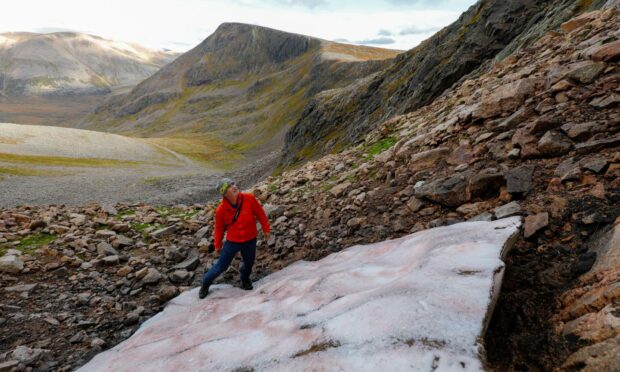Scotland’s most famous snow patch is now smaller than an A4 sheet of paper according to experts and could be gone in 48 hours if the mild weather holds.
Against all the odds, the snow patch – which is known as the Sphinx – has clung on “by its fingertips” after it was expected to disappear earlier in the month.
But its future now looks bleak.
An extraordinarily close call
The presence of the Sphinx dates back hundreds of years but two weeks ago mountaineers began warning that it was unlikely to survive the week.
If it melts, it will be the third time in five years this has occurred. Prior to that, it has only disappeared five times in the last 300 years.
A flurry of snow meant that it has managed to hold on longer than expected.
Against the odds, the Sphinx patch at Garbh Choire Mòr clung on by its fingertips to be buried by the new snow last week. However, it’s now smaller than an A4 sheet of paper, as excavated today by Colin Hutt. It’ll melt in the next 48 hours in very mild conditions. pic.twitter.com/GO6rDSuhHs
— Iain Cameron (@theiaincameron) October 25, 2021
Snow patch expert Iain Cameron has been closely following the Sphinx’s chilling final days.
He believes it will likely melt in the next 48 hours thanks to the wet and mild conditions at Braeriach, the UK’s third-highest mountain where the Sphinx is located.
Due to its isolated location in the heart of the Cairngorms, it’s not always easy to check on the Sphinx’s status.
Last week, when it was visited by mountaineer Colin Hunt the patch of snow was less than a metre long.
Extraordinarily close call for The Sphinx. It was visited today just before noon, and found to be tiny. Less than 1m long, but crucially only a few cms thick. The view of myself and another expert observer is that it melted today, probably around 4pm.
📷 Colin Hutt
1/2 pic.twitter.com/e6SkyWxgxO
— Iain Cameron (@theiaincameron) October 20, 2021
“We think the Sphinx has gone,” Iain said on Saturday, “but it’s not been confirmed.”
“There was a visit on Wednesday and it was still there but tiny, literally a couple of foot long.
“Heavy snow fell that afternoon and would’ve buried the location. Whether a sliver survived we don’t know, so another trip is planned soon to check.”
The heavy shower blanketed the original small patch of snow with fresh powder, but it does not seem to have been enough to save it.
The beginning of the end for Scotland’s Sphinx
To check on the now-buried Sphinx, experts had to dig through the new snowfall until they found the solid, slightly discoloured piece of compacted ice which has survived from last winter.
So, to recap, that’s now 1933, 1959, 1996, 2003, 2006, 2017, 2018 & 2021 all snow at this location has melted since the 1700s. This will leave Aonach Beag as Scotland’s sole-surviving patch of snow in 2021.
— Iain Cameron (@theiaincameron) October 25, 2021
“It looks really inconsequential, but actually it can tell us a lot more than we might first think,” said Iain.
“Snow patches like this act as a barometer for what the wider climate is doing, and I think that’s borne out by the evidence we are seeing – just the minimal amount of patches surviving these days compared to how they used to.
It may be particularly prophetic that the Sphinx may disappear within days of the COP26 summit beginning in Glasgow, where mitigating the effects of climate change will be top of the agenda.
